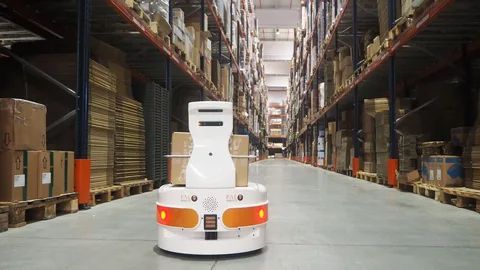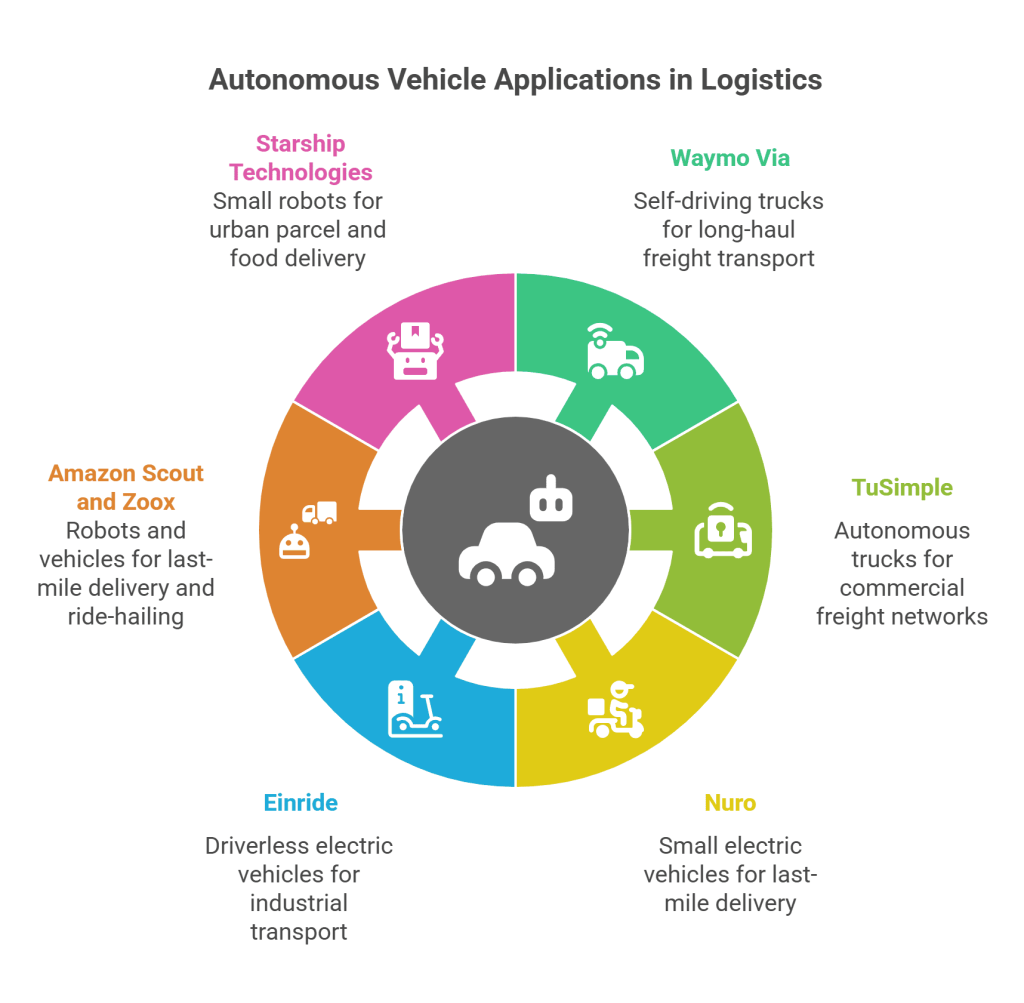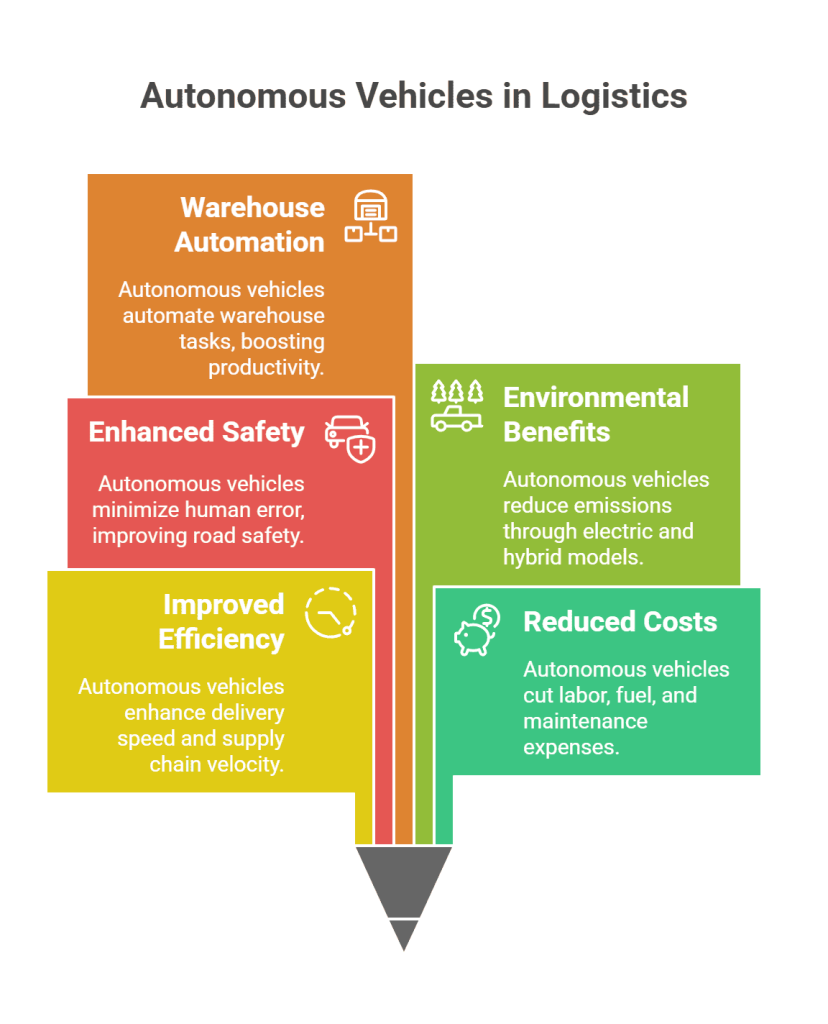In recent years, the logistics and transportation sectors have undergone significant transformation due to the rise of autonomous technologies. Among these innovations, autonomous vehicles stand out for their potential to revolutionise how goods are transported, managed, and delivered. In this blog, we explore autonomous vehicle examples and examine their profound impact on logistics operations.

What Are Autonomous Vehicles?
Autonomous vehicles are self-driving cars that move in warehouse facilities without manual assistance. Equipped with AI sensors, these vehicles clear objects, avoid obstacles, and operate efficiently in risky zones. They use a combination of sensors, cameras, radar, LiDAR, GPS, and artificial intelligence (AI) to perceive their environment and make real-time driving decisions.
While the concept was once confined to science fiction, it has now become a reality. Companies and researchers across the globe are testing and deploying autonomous vehicles to improve efficiency, reduce costs, and mitigate human error. The role of automation in the automotive industry will increase significantly in the future.
Autonomous Vehicles Examples in Logistics

Let’s dive into some real-world autonomous vehicle examples that are actively shaping the logistics landscape:
1. Waymo Via (Alphabet Inc.)
Waymo, originally developed under Google, has expanded into logistics through Waymo Via. They develop self-driving trucks that have been tested for freight transport across states like California, Texas, and Arizona. All their vehicles contain AI motion sensors that guide them for obstacle collision, traffic management, and route identification.
2. TuSimple – Autonomous Vehicle Examples
TuSimple is a truck manufacturing company that develops freight and heavy-duty vehicles. Their autonomous trucks have achieved successful test runs without human drivers over thousands of miles. The company has collaborated with UPS and Navistar to build a commercial-ready autonomous freight network.
3. Nuro
Nuro specialises in small, electric, autonomous delivery vehicles and mobile robots designed for last-mile logistics. These compact vehicles are being used by companies like Domino’s and Kroger to deliver groceries and food in suburban neighbourhoods.
4. Einride
Einride, a Swedish tech company, has introduced the “Pod” – an electric, driverless freight vehicle with no cabin for human drivers. The Pod is designed for short-haul transport within industrial zones and warehouses.
5. Amazon Scout and Zoox
Amazon is investing heavily in autonomy through projects like Scout, a sidewalk delivery robot, and Zoox, an autonomous ride-hailing vehicle. These tools streamline last-mile delivery and reduce reliance on human labour.
6. Starship Technologies
This company deploys small, six-wheeled autonomous robots for delivering parcels, groceries, and food in urban environments. These robots are already operational in university campuses and select neighbourhoods.
These autonomous vehicle examples highlight how the logistics ecosystem is evolving to embrace automation and AI to optimize operations.
How Autonomous Vehicle Examples Are Impacting Logistics

Autonomous vehicles bring several transformative benefits to the logistics industry. Let’s explore their key impacts:
1. Improved Efficiency and Speed
Autonomous vehicles can operate 24/7 without breaks, unlike human drivers who require rest periods. This leads to faster delivery times and increased supply chain velocity. For long-haul freight, the ability to drive continuously without fatigue significantly reduces transit times.
2. Reduced Operating Costs
Although the initial investment in autonomous vehicles is high, the long-term savings can be substantial. Logistics companies can reduce labor costs, fuel expenses (through optimized driving), and maintenance costs due to fewer accidents and mechanical issues.
3. Enhanced Safety
According to the National Highway Traffic Safety Administration (NHTSA), 94% of vehicle accidents are caused by human error. By removing the human element, autonomous vehicles can dramatically improve road safety, especially for freight carriers navigating busy highways.
4. Environmental Benefits
Most autonomous vehicle projects are electric or hybrid, contributing to reduced carbon emissions. Efficient route planning and fuel optimisation algorithms also help minimise wasteful driving practices.
5. Warehouse and Yard Automation
Autonomous vehicles are also being integrated into warehouse and yard management systems. Forklifts, yard trucks, and guided vehicles are automating tasks like inventory movement, loading/unloading, and internal goods transfer.
These impacts, combined with growing autonomous vehicles, are redefining logistics strategy for companies worldwide.
Challenges of Autonomous Vehicles in Logistics
Despite the benefits, the adoption of autonomous vehicles faces several hurdles:
1. Regulatory and Legal Issues
Laws regarding autonomous vehicle operation vary widely across countries and states. Legal liability in case of accidents, insurance frameworks, and compliance standards are still being defined.
2. Technology Maturity
Autonomous technology is not yet foolproof. Weather conditions, complex road environments, and unpredictable human behaviour pose challenges to full autonomy.
3. High Initial Investment
Building and deploying a fleet of autonomous vehicles requires substantial capital. For small and medium logistics providers, the costs may outweigh the short-term benefits.
4. Cybersecurity Risks
Autonomous vehicles rely heavily on connectivity and cloud data. This makes them vulnerable to cyberattacks that could compromise vehicle control or supply chain data.
Nonetheless, with continuous innovation and strong autonomous vehicles examples emerging globally, these challenges are gradually being addressed.
Future Outlook of Autonomous Vehicles in Logistics
As 5G networks, AI algorithms, and sensor technologies improve, autonomous vehicles will become more reliable and accessible. Analysts predict that autonomous trucks will be commercially viable by the end of the decade, especially for long-distance freight and warehouse automation.
Moreover, companies are increasingly piloting autonomous vehicles in the middle-mile and last-mile delivery segments, which are known for their high labour and fuel costs. Many autonomous vehicle examples exist to future-proof warehouse operations.
In the near future, we may see:
- Autonomous convoys where one human-driven truck leads several autonomous ones.
- Smart logistics hubs that use autonomous robots for internal and external goods movement.
- On-demand autonomous deliveries for retail and e-commerce, reducing the burden on traditional couriers.
FAQs: Autonomous Vehicle Examples
1. What are some common autonomous vehicle examples in logistics?
Autonomous vehicles examples include Waymo Via’s freight trucks, TuSimple’s long-haul trucks, Nuro’s last-mile delivery pods, and Starship Technologies’ delivery robots.
2. How do autonomous vehicles improve logistics?
They reduce delivery times, cut operational costs, improve safety, and enable round-the-clock transport, making supply chains more agile and cost-effective.
3. Are autonomous vehicles safe for logistics use?
Yes, when properly tested and regulated. Many autonomous vehicles are equipped with advanced sensors and AI that minimise human error. However, real-world conditions still pose some risks.
4. What challenges do companies face in adopting autonomous logistics solutions?
Regulatory restrictions, high costs, technological limitations, and cybersecurity threats are key challenges that companies must address before large-scale deployment.
5. Are autonomous vehicles only used for road logistics?
No. Autonomous vehicles are also used in warehouse facilities, manufacturing hubs, and factory floors.
Conclusion
The integration of autonomous vehicles in logistics is no longer a futuristic vision — it’s a fast-developing reality. With real-world autonomous vehicle examples like Waymo Via, TuSimple, Nuro, and others leading the way, supply chains are witnessing a shift towards greater automation, efficiency, and sustainability.
As technology continues to mature and regulations evolve, autonomous vehicles will become more mainstream, reshaping how goods move across the globe.
From enhancing productivity to improving road safety, autonomous vehicles are poised to be a game-changer in the logistics sector. Want detailed strategies to overcome supply chain bottlenecks? Contact Qodenext today.






